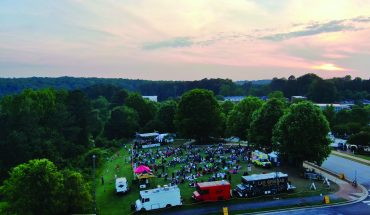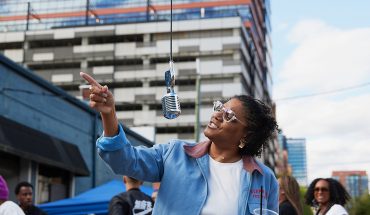
courtesy Durham Arts Council
The first major installation in Durham’s decade-long public art initiative is in progress this month: a large-scale banner “art wrap” of the Corcoran Street parking garage, near American Tobacco campus and DPAC. The as-yet-untitled work by artist Olalekan Jeyifous (“LEk,” pronounced lake) vibrantly celebrates Durham’s culture, past and present. “It’s multicultural, multicolored—
it really represents the melting pot of Durham,” says Sherry DeVries, executive director of the Durham Arts Council.
The mural publicly kicks off the Durham SmART Initiative, part of the N.C. Arts Council’s statewide initiative by the same name, which supports and encourages creative placemaking. “Public art initiatives can create the fabric of experience in a downtown area,” says DeVries. In Durham, the SmART task force plans to transform a 1-and-a-half-mile corridor through downtown Durham with murals, striking lighting, stages, and sculpture. The idea is to mirror the energy of what’s going on inside these buildings, DeVries says. This month’s installation, for instance, faces DPAC. “If you’re at DPAC and you look upward toward downtown Durham at night—even in the daytime—it’s, well, it’s pretty dull. At night, there’s not a lot of lighting. … It’s not very inviting to cross the railroad tracks and walk two blocks up into the city center.”
The art wrap should set a different tone. The abstract take on a massive banner version of a quilt features imagery familiar to locals: American Tobacco, the Lucky Strike tower, Unscripted hotel, the Durham Bulls, Hayti Heritage Center. There are motifs and less-obvious symbols, as well. “I hope the public feels that they can see their city in it,” LEk says. “I also want people to continually discover new things in the work.”
Artist LEk is based in Brooklyn but spent time in Durham before envisioning the piece. “I want to reflect on the history, change, and community through abstract, non-hierarchical, and multi-scalar snapshots of the past, the present, and future of this area of Durham.” He hosted “community engagement” sessions and took “a bunch of photographs” to set the tone, and he was inspired by what he found. “I think sometimes not being from a particular place can be an advantage to creating artwork for that place. Your excitement and enthusiasm is fresh and new.” —Jessie Ammons Rumbley



